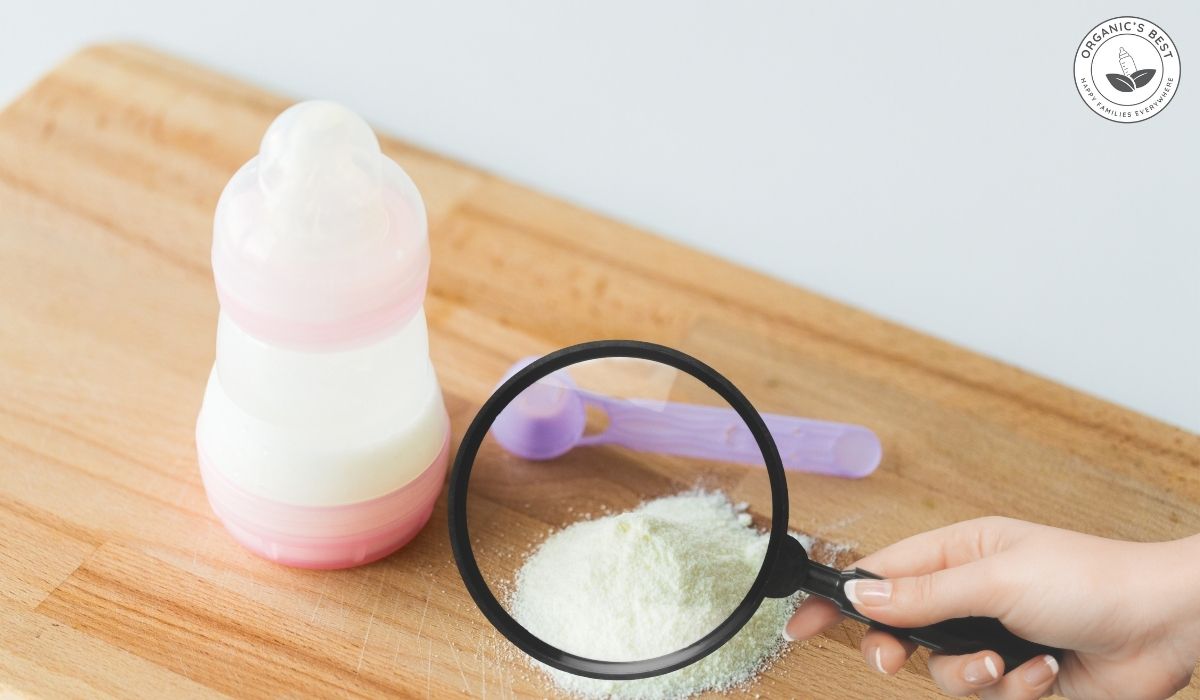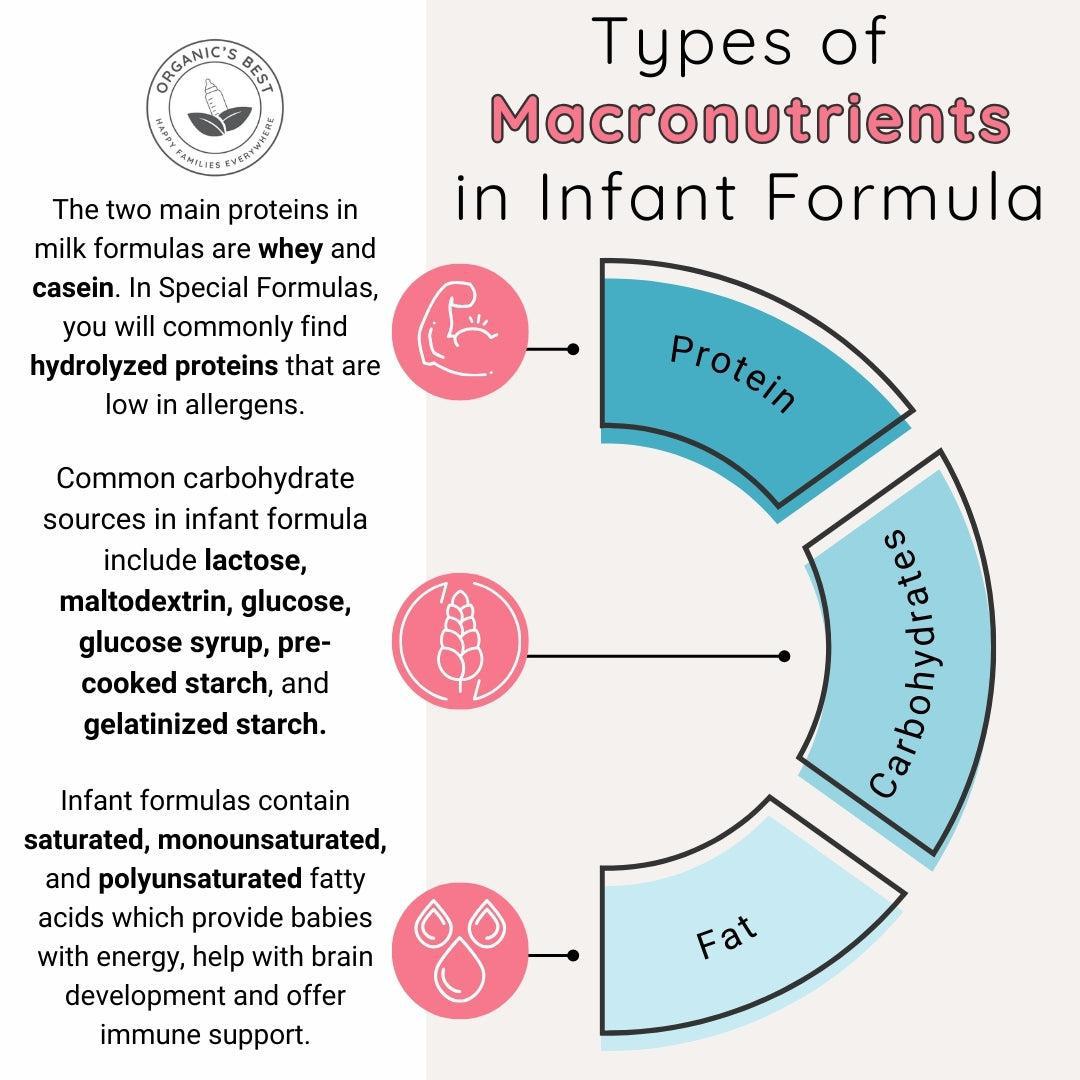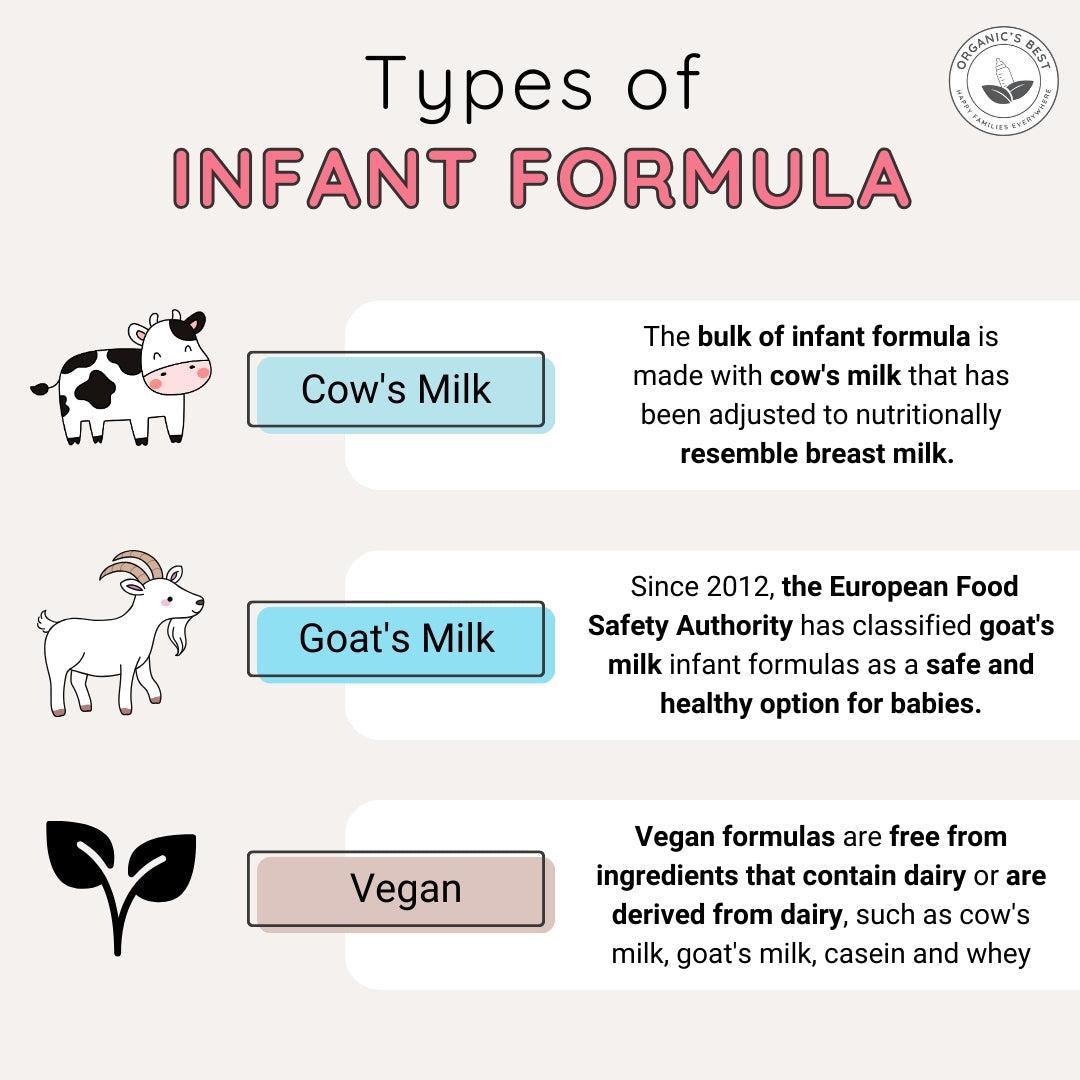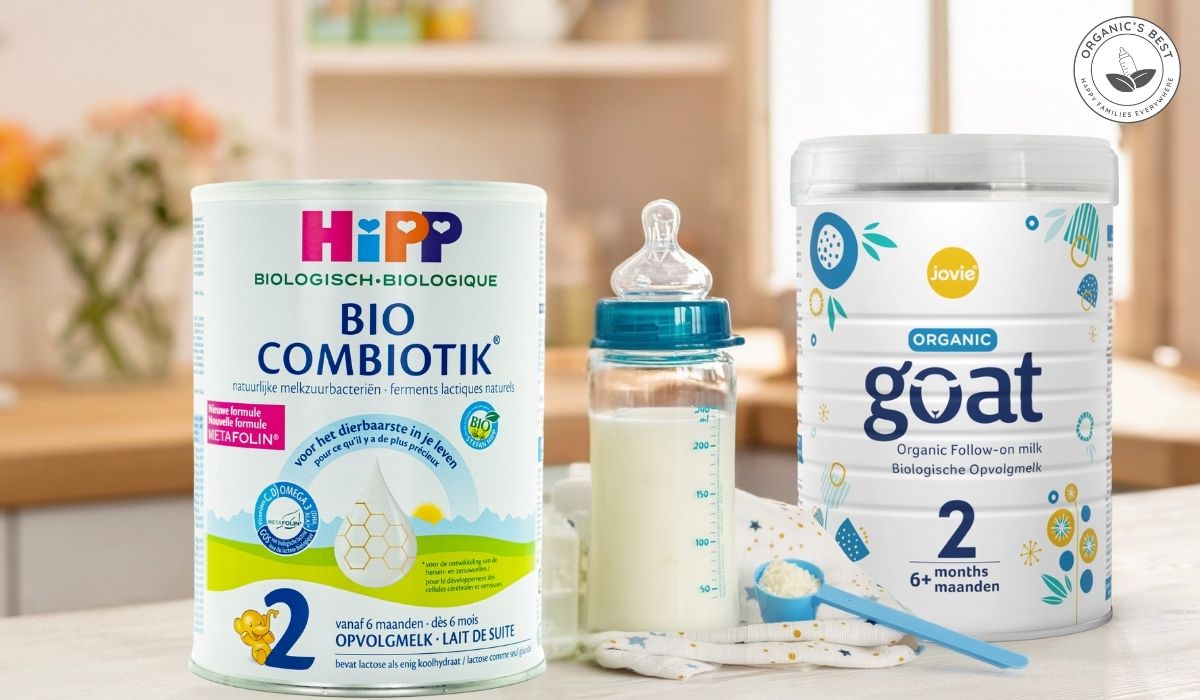Click to Get 2 FREE Boxes/Cans
Only New Customers! Click HERE to Get 2 Extra Boxes/Cans for Free With Your First Order.
BABY FORMULA
Offering new parents top-quality European infant formula from renowned brands like HiPP, Holle, Kendamil, and more. If you’re uncertain about which product to choose, our Formula Finder can help you make the best decision for your baby.
Baby Food
Offering new parents a premium selection of European baby foods, including jars, pouches, cereals, and snacks from esteemed brands like HiPP and Holle.
Baby Formula Ingredients: What is Baby Formula Made of?
by Agustina Fernandez May 09, 2024 9 min read

European baby formula manufacturers are experts at utilizing cutting-edge infant nutrition science to replicate many of the critical nutrients found in breast milk- the ultimate source of nourishment for little ones.
With baby formula ingredient regulations overseen by the strict control of the European Union (EU), parents can trust infant formula manufacturers to provide the best for their babies.
While every baby formula is crafted to be nutritionally complete, the amount and variety of baby formula ingredients may vary between brands and types of formula to accommodate different dietary needs. For instance, there may be increased macronutrients that formula for premature infants.
In this article, we break down what's in your baby's bottle, offering insight into the main and accessory ingredients. After reading, you'll have a better understanding of how baby formulas are used to fuel growth and development, allowing you to make informed choices about your baby's diet.
Table of contents
Nutritional Composition of Infant Formula
To ensure nutritional adequacy, infant formula manufacturers must adhere to strict guidelines set by regulatory bodies. In the United States, the Food and Drug Administration (FDA) is the overarching control body, while the European Food Safety Authority (EFSA) plays a similar role in Europe. In this section, we'll compare the differences between regulations in America and Europe.
How Are European Baby Formula Guidelines Different than in America?
Manufacturers in both parts of the world focus on replicating the important components found in breast milk to support the growth and development of babies, but when it comes to certain ingredients, the approaches of these regulatory bodies differ.
Fats, proteins, and carbohydrates are the three main macronutrients that make up the bulk of baby formulas. The standards for these macros are fairly similar between Europe and the US, with, for example, minimal levels of protein both set at 1.8 g/100 kcal for formulas made with cow's or goat's milk.
However, in the EU, regulations mandate that at least 30% of the total carbohydrate content in milk-based formula must come from lactose, mirroring the main carbohydrate found in breast milk. In contrast, the US does not impose a minimum lactose requirement.
Additionally, recent data reveals that about half of all infant formula sales in the US are for a lactose-reduced or lactose-free formula, with corn syrup solids acting as the first choice for a lactose replacement.
Another key difference concerns Docosahexaenoic acid or DHA. Docosahexaenoic acid is a required ingredient for formulas in Europe, but it remains optional in the USA despite clinical studies identifying this essential fatty acid as crucial for neurodevelopment. We discuss this ingredient more in-depth later on in this article!
Finally, formula and food for infants under 3 years old in Europe are subject to special contaminant checks and must meet more stringent limits than conventional products. Now that we have uncovered some of the differences between the general composition of European vs US baby formula, let's delve into how these nutrients impact a child's growth and development!

Protein
The two main proteins in dairy milk are whey and casein. In the early stages of breastfeeding, the whey protein levels in breast milk are higher. Whey protein tends to be easier to digest because it stays liquid in the stomach, unlike casein. Whey-dominant milk is ideal for newborns, as they need easily digestible and quickly absorbed energy to help them grow.
This ratio changes to provide higher levels of casein over time, which helps babies feel full. Accordingly, many brands in Europe, like Kendamil or Lowenzahn Organics, adjust the protein ratios in different stages of their formula to reflect the maturation process of human milk.
Protein Source: Standard Milk Formulas vs Special Formulas
The protein sources in special infant formulas differ from conventional milk formulas in terms of accommodating dietary restrictions. For instance, in a hypoallergenic baby formula like HiPP HA, you will find proteins that have undergone a process of hydrolyzation. This process removes complex milk proteins, leaving behind smaller and more digestible hydrolyzed proteins that are lower in allergens.
These formulas are meant to minimize the risk of allergies and are well suited to babies with sensitivities to milk. However, in most run-of-the-mill baby formula, milk proteins are left fully intact.
Fat
Breast milk and infant formulas contain saturated, monounsaturated, and polyunsaturated fatty acids that provide babies with energy, enhance the absorption of fat-soluble vitamins, support healthy brain development, and provide immune support.
Many different kinds of fatty acids are found in some of the best European formulas, including docosahexaenoic acid (DHA) and arachidonic acid (ARA), two long-chain polyunsaturated fatty acids found in human milk that support vision and brain development.
Carbohydrates
Carbs are a critical source of energy for babies and help regulate the use of fats and proteins to support other essential bodily functions. Some brands also add additional carbohydrate sources or substitute lactose with ingredients such as maltodextrin, glucose, glucose syrup, pre-cooked starch, and gelatinized starch, which are all acceptable carb sources per the guidelines given by the European Commission. Generally, in European formulas, the most common carbohydrate is lactose, followed by starch and maltodextrin, which play a complementary role.
Nutritional Composition: Cow, Goat, and Vegan Baby Formulas
While the nutrient content of all products throughout the infant formula industry is made to offer optimal nutrition for babies, certain baby formula ingredients, like the type of milk used, work well for some babies but not others. We'll take an in-depth look at this now.

Cow's Milk Baby Formula
The bulk of infant formula is made with cow's milk that has been adjusted to nutritionally resemble human breast milk. It is the go-to choice often recommended by pediatricians for healthy babies. As with any animal milk, cow milk contains both whey and casein proteins, which both contain essential amino acids.
As discussed above, the ratios of whey vs. casein can impact the digestibility of milk formula and can differ between brands and products.
One factor worth mentioning is that some brands, like Kendamil, include whole milk in their formulas, whereas other brands rely only on skimmed milk while adding vegetable oils to make up for the milk fats that have been removed.
Consequently, products made with skimmed milk will often contain palm oil to provide palmitic acid, which human milk contains, but products based on whole milk are already naturally abundant in this nutrient and, thus, are typically palm oil-free.
As for specific micronutrients like vitamins and minerals, all formula is fortified with essential nutrients, regardless of whether the formula is based on cow's milk, goat's milk, or a vegan source. This means that their nutritional value does not vary much.
Goat's Milk Baby Formula
Goat's milk formulas, such as those carried by HiPP Goat, Holle Goat, and Jovie Goat, have become increasingly popular in the European baby food market. Since 2012, the European Food Safety Authority has classified goat's milk infant formulas as a safe and healthy option for babies.
A key benefit is that goat's milk can be digested up to 2x faster than cow's milk baby formula due to it producing smaller and softer milk curds that are broken down more easily in your baby's belly. Goat milk's protein profile is also closer to that of human breast milk because it is naturally A2 or, in other words, A1 casein-free.
Finally, goat milk has a lower lactose content than cow's milk, which can be ideal for babies with mild lactose sensitivities, but it is still unsuitable for true lactose intolerance or cow's milk protein allergy.
Vegan Baby Formula
Vegan infant formulas are a newer product on the market. Vegan formulas are free from ingredients that contain dairy or are derived from animal products. Thus, they are sometimes recommended for cases of a milk protein allergy or lactose intolerance.
With the rise in demand for formulas made strictly from plant-derived ingredients, infant food manufacturers have responded with two main types. The first type is soy-based formulas, which may not be favourable due to soy isoflavones, a chemical compound similar to estrogen that may interfere with the normal function of the thyroid gland. Soy also contains phytates, which may impact the absorption of certain minerals.
A popular alternative to soy-based infant formula products is a vegan formula made from hydrolyzed rice, such as the offerings of Bebe M, which are classified by the EFSA as "Food for special medical purposes"(FSMPs).
These formulas should be used only under medical supervision and when standard cow or goat milk formula is not suitable. Despite hydrolyzed rice formulas being classified as FSMPs, they are still considered to be a safe and nutritionally adequate replacement for exclusive breastfeeding.
Learn more Vegan Baby Formula: Good or Bad?
Main Ingredients in Baby Formula
You are sure to spot the following ingredients on almost every European formula label as they comprise the basis of nutritionally complete milk.
Minerals in Baby Formula
Baby formula is enriched with a variety of minerals, but iron and calcium stand out as being particularly important to your baby's health.
Iron is an essential part of dispersing oxygen in red blood cells and supporting neurological development. It is recommended by ESPGHAN (The European Society for Paediatric Gastroenterology Hepatology and Nutrition) that healthy formula-fed infants receive 4 to 8 mg of iron from their formula, and after 6 months, other iron-rich foods can slowly be introduced to complement their diet.
Preterm infants or those with low birth weights may require additional iron. It's worth noting that the required iron content is lower in Europe than the recommendations put forward by the American Academy of Pediatrics.
Calcium, on the other hand, directly affects bone structure, especially during periods of growth like infancy and childhood. Insufficient calcium intake during childhood can raise the risk of fractures and rickets and hinder the attainment of peak bone mass in adulthood.
During the first year, it is recommended that babies get between 200 and 260mg of calcium each day.
Vitamins in Formula
As with minerals, infant formula is fortified with a plethora of vitamins. Let's take a look at some of the vitamins that are important for your baby now:
-
Vitamin A: Aids in skin, hair, and eye health and benefits the immune system.
-
Vitamin B1: Helps turn food into energy, is crucial for brain and nervous system development, and prevents complications in various bodily systems and organs.
-
Vitamin B6: Supports brain development and the immune system.
-
Vitamin B12: Supports the health of nerve and blood cells and is involved in the creation of DNA.
-
Vitamin C: Defends against infections and helps the body heal. It's also important for building healthy bones and muscles.
-
Vitamin D: Assists in the absorption of calcium and phosphorus. Inadequate vitamin D levels can lead to rickets, a condition characterized by weakened and softened bones.
DHA
Up until recently, infants have primarily received DHA through breast feeding, but as of 2020, the European Commission has made this long-chain polyunsaturated Omega-3 fatty acid a mandatory ingredient in all infant formulas.
DHA has many potential benefits, with studies suggesting that getting an adequate amount of DHA in the early stages of life can have drastic effects on the functional maturation of an infant's brain and long-term neurological development.
Optional Ingredients Sometimes Used in Baby Formula
The formula ingredients we cover next are not mandatory ingredients, so manufacturers are free to include or exclude them in their baby formula recipes as they wish. Let's discuss what value they might have for your baby now!
Probiotics and Prebiotics
Prebiotics are non-digestible fibers that feed probiotics, the healthy bacteria living in our guts. Together, they promote the development of healthy gut microflora in the body, enhance the protective properties of the immune system, and facilitate better digestion.
Human Milk Oligosaccharides (HMOs)
HMOs are complex sugars found in human milk. The composition of HMOs varies between the breast milk of different mothers and also changes throughout lactation. Similar to the prebiotics GOS and FOS, HMOs act as indigestible dietary fibers for newborns and play a crucial role in nourishing beneficial gut bacteria, promoting a robust gut microbiome.
Nucleotides
Nucleotides are part of the building blocks of DNA and RNA. They are found in breast milk at even higher concentrations than bovine milk, and therefore, to mimic breast milk, some formulas contain this ingredient.
Anecdotal evidence suggests that they help to support the development of the small intestine, immune function, overall gut health and early infant growth.
Soy
As we mentioned earlier, soy-based formulas contain isoflavones, which have properties similar to those of estrogen, which is why some parents prefer to avoid them. However, soy can also be used in milk-based formulas for several reasons.
Primarily, it is a source of fiber, protein, and omega-3 fats. Additionally, soy lecithin may be used to emulsify food products.
You may be interested in reading Revealing the Truth About Soy Formula

Our TOP Formula Recommendations
Each baby is unique, which can make finding the perfect formula tricky. But don't worry-we have simplified this decision-making process with an interactive quiz that will match you to the formula best suited to your little one's needs. Give it a try for yourself!
Conclusion on Ingredients in Baby Formula
Thanks to advancements in infant nutrition, babies who are fed formula can now benefit from a wide range of nutrients that mirror those found in human milk, helping them thrive and grow.
Parents can rest assured knowing that baby formula ingredients are rigorously regulated in Europe, ensuring the safety and nutritional adequacy of these products for their little ones. Our store is committed to providing peace of mind by selecting products with the highest quality ingredients available!
Disclaimer:Please be aware that this information is based on general trends in babies, and it is not medical advice. Your doctor should be your first source of information and advice when considering any changes to your child's formula and when choosing your child's formula. Always consult your pediatrician before making any decisions about your child's diet or if you notice any changes in your child. Breastfeeding is the best nutrition for your baby because breast milk provides your child with all the essential nutrients they need for growth and development. Please consult your pediatrician if your child requires supplemental feeding. |
Agustina Fernandez
Dr. Agustina Fernandez earned her medical degree from the prestigious Universidad Nacional de Córdoba, Argentina. With a deep-rooted passion for pediatrics, Dr. Fernandez is currently on the path to specializing in children's healthcare. Recently, she has delved into the vital field of infant nutrition. Her research interests include breastfeeding, infant formula, and baby food in little ones’ formative years. Dr. Fernandez's commitment to this area of study underscores her dedication to ensuring the health and well-being of children from their earliest days.
Leave a comment
Comments will be approved before showing up.
Also in Organic Infant Nutrition and Health Blog

How to Choose The Best Infant Formula: A Guide to EU Organic Formulas
by Agustina Fernandez January 05, 2026 14 min read
Read More
Best Formula for Breastfed Babies 2026 Guide
by Agustina Fernandez January 05, 2026 15 min read
Read More
Reviewed by Dr. Po-Chang Hsu, MD, MS
-

Dr. Po-Chang Hsu: Medical Reviewer of Organic's Best Blog
Dr. Hsu received his medical degree from Tufts University in Boston, Massachusetts, and holds a Master’s of Science degree from both Harvard University and Tufts University.

